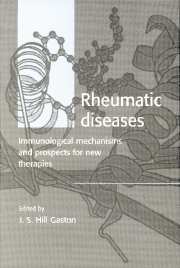Book contents
- Frontmatter
- Contents
- List of contributors
- 1 Implications of advances in immunology for understanding the pathogenesis and treatment of rheumatic disease
- 2 The role of T cells in autoimmune disease
- 3 The role of MHC antigens in autoimmunity
- 4 B cells: formation and structure of autoantibodies
- 5 The role of CD40 in immune responses
- 6 Manipulation of the T cell immune system via CD28 and CTLA-4
- 7 Lymphocyte antigen receptor signal transduction
- 8 The role of adhesion mechanisms in inflammation
- 9 The regulation of apoptosis in the rheumatic disorders
- 10 The role of monokines in arthritis
- 11 T lymphocyte subsets in relation to autoimmune disease
- 12 Complement receptors
- Index
7 - Lymphocyte antigen receptor signal transduction
Published online by Cambridge University Press: 06 September 2009
- Frontmatter
- Contents
- List of contributors
- 1 Implications of advances in immunology for understanding the pathogenesis and treatment of rheumatic disease
- 2 The role of T cells in autoimmune disease
- 3 The role of MHC antigens in autoimmunity
- 4 B cells: formation and structure of autoantibodies
- 5 The role of CD40 in immune responses
- 6 Manipulation of the T cell immune system via CD28 and CTLA-4
- 7 Lymphocyte antigen receptor signal transduction
- 8 The role of adhesion mechanisms in inflammation
- 9 The regulation of apoptosis in the rheumatic disorders
- 10 The role of monokines in arthritis
- 11 T lymphocyte subsets in relation to autoimmune disease
- 12 Complement receptors
- Index
Summary
Introduction
Lymphocytes can be separated into thymus-derived cells (T cells) that are specialized for protecting the body against intracellular pathogens (cell-mediated immunity) and the bone-marrow derived cells (B cells, originally described in the bursa of Fabricius in the chicken) that protect against extracellular pathogens (humoral immunity). The specificity of these responses is achieved by the expression of clonotypic B and T cell antigen-specific receptors on the lymphocyte surface, known as the BCR and TCR, respectively. The BCR is specialized for the recognition, capture and internalization of antigens for processing and presentation on the cell surface in association with MHC class II molecule. The TCR is specialized for the recognition of small peptides presented on antigen-presenting cells in association with MHC class I or class II molecules. The peptides are typically 8–10 amino acid residues long when in association with class I molecules and rather more variable in length (typically 10–20 residues) when in association with class II molecules.
The outcome of BCR or TCR engagement by ligands depends on the avidity of the interaction, the length of time for which ligands bind, the lymphocyte differentiation state and the nature of other co-stimulatory signals being received by the cell. A fascinating aspect of antigen receptor signalling is that the same receptor can mediate signals resulting in apoptosis, activation or cellular non-responsiveness (‘anergy’) depending on the interplay between these four variables.
- Type
- Chapter
- Information
- Rheumatic DiseasesImmunological Mechanisms and Prospects for New Therapies, pp. 119 - 152Publisher: Cambridge University PressPrint publication year: 1999



